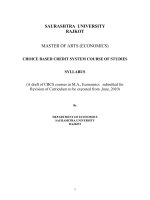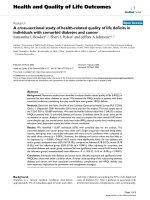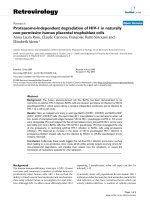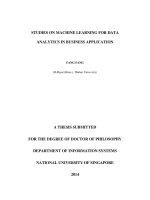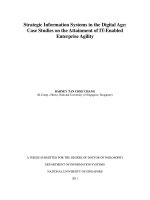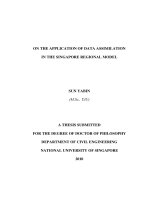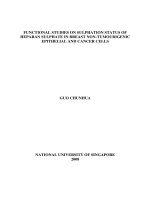Functional studies on sulphation status of heparan sulphate in breast non tumourigenic epithelial and cancer cells
Bạn đang xem bản rút gọn của tài liệu. Xem và tải ngay bản đầy đủ của tài liệu tại đây (3.76 MB, 289 trang )
FUNCTIONAL STUDIES ON SULPHATION STATUS OF
HEPARAN SULPHATE IN BREAST NON-TUMOURIGENIC
EPITHELIAL AND CANCER CELLS
GUO CHUNHUA
NATIONAL UNIVERSITY OF SINGAPORE
2008
FUNCTIONAL STUDIES ON SULPHATION STATUS OF
HEPARAN SULPHATE IN BREAST NON-TUMOURIGENIC
EPITHELIAL AND CANCER CELLS
GUO CHUNHUA
(B.Med., M.Med.)
A THESIS SUBMITTED
FOR THE DEGREE OF DOCTOR OF PHILOSOPHY
DEPARTMENT OF ANATOMY
FACULTY OF MEDICINE
NATIONAL UNIVERSITY OF SINGAPORE
2008
Acknowledgements
i
ACKNOWLEDGEMENTS
I would like to express my deepest gratitude and indebtedness to Assistant
Professor Yip Wai Cheong, George, Department of Anatomy, Yong Loo Lin School
of Medicine, National University of Singapore (NUS), for his invaluable guidance,
advice and instruction, without which this work would not have been possible. He has
guided me throughout the study with his original ideas, critical comments, as well as
continuous encouragement and patience. Apart from it, I have learned a lot from him
regarding the attitude and philosophy to research, and life as well.
I deeply appreciate my co-supervisor, Professor Bay Boon Huat, Department
of Anatomy, Yong Loo Lin School of Medicine, National University of Singapore
(NUS), for his open-mindedness, expert advice and pivotal suggestions, which have
enlightened me and inspired my independent thinking. His consistent encouragement
and support have been essential for the completion of this study.
It was a great honor to be supervised by them. The precious experience of
working with them will benefit me in my future career.
My sincere appreciation is given to Professor Ling Eng Ang, the Head of
Department of Anatomy, Yong Loo Lin School of Medicine, National University of
Singapore (NUS), for the opportunity to pursue my Ph D candidature in the
Department of Anatomy. His positive and energetic attitude helped me throughout the
ups and downs of the whole research. He has impressed and influenced me with his
amiability and gentlemanly manner.
I wish to express my heartfelt thanks to my former supervisor Assistant
Professor Valerie Lin Chun-Ling, School of Biological Sciences, Nanyang
Technological University. She has not only introduced me to an entirely new basic
Acknowledgements
ii
research field but also has been a role model for hardworking and commitment to
research. Her deep and sustained interest, immense patience and stimulating
discussions have been most invaluable later in my Ph.D study.
My sincere appreciations are to Ms. Chan Yee Gek, and Ms. Wu Ya Jun who
have assisted me in the learning of confocal and electron microscopy as well as
immunohistological techniques. I must also acknowledge my gratitude to Mrs Ng
Geok Lan and Mrs Yong Eng Siang for their excellent technical assistance; I am very
grateful to Mr Yick Tuck Yong for his constant assistance in computer work, Mr Lim
Beng Hock for looking after the experimental animals, Mdm Ang Lye Gek Carolyne,
Mdm Teo Li Ching Violet, and Mdm Singh for their secretarial assistance.
I am also grateful to fellow students who have spent time in our research group. In
particular, I am grateful to Ms. Koo Chuay Yeng, Ms.Yvonne Teng, Ms.Choo Siew
Hua, Dr. Zou Xiaohui. They are always so patient and like to discuss all of the
problems during the research.
I would also like to express my earnest gratitude to all the staff members of the
Department of Anatomy, Yong Loo Lin School of Medicine, National University of
Singapore (NUS) for their generous help and friendship. I continue to thank the
academic and technical staff of the BFIG lab (Clinical Research Center, Faculty of
Medicine) for their support in my Affymetrix GeneChip analysis project.
It has indeed been my good fortune to work with Mr. Li Wenbo, Mr. Xia Wenhao, Mr.
Guo Kun, Ms. Wu Chun, Ms.Yin Jing. The friendly atmosphere they created has been
unforgettable. Their support helped me a lot during the writing of my thesis.
Acknowledgements
iii
I would also like to thank my former colleagues Ms.Woon Chow Thai,
Dr.Zheng Ze Yi, Dr. Cao Sheng Lan and Mrs. Joyce Leo Ching Li for their generous
help and friendship.
I greatly acknowledge the National University of Singapore for giving me the
Research Scholarship, without which I can not finish my Ph.D. study.
I am also deeply indebted to my parents, brother and sister-in-law for their
unfailing love, concern and support in my past years.
Table of Contents
iv
TABLE OF CONTENTS
ACKNOWLEDGEMENTS i
TABLE OF CONTENTS iv
SUMMARY ix
LIST OF TABLES xii
LIST OF FIGURES xiv
LIST OF ABBREVIATIONS xvii
LIST OF PUBLICATIONS……………………………………………………… xx
CHAPTER 1 INTRODUCTION 1
1.1 Introduction of breast cancer 2
1.1.1 Epidemiology of breast cancer 3
1.1.2 Risks of breast cancer 4
1.1.3 Classification of breast cancer 6
1.1.4 Diagnostics of breast cancer 7
1.1.5 Treatment of breast cancer 9
1.1.5.1 Locoregional therapy 8
1.1.5.2 Systemic therapy 9
1.2 Proteoglycan and glycosaminoglycans (GAGs) 13
1.3 Heparan Sulphate Protoglycan (HSPG) 18
1.3.1 Introduction of HSPG
18
1.3.2 Synthesis of HS 19
1.3.3 Function of HS 23
1.3.3.1 HS and cell proliferation / growth 25
1.3.3.2 HS and cell adhesion 27
1.3.3.3 HS and cell migration 29
1.3.3.4 HS and cell invasion 30
1.3.3.5 HS and angiogenesis 31
1.3.4 3-O sulphation in HS 33
1.4 RNAi technology 36
1.4.1 Introduction of RNAi
36
1.4.2 Mechanism of RNAi 36
Table of Contents
v
1.4.4 RNAi and cancer 37
1.4.4 RNAi and proteoglycans 39
1.5 Genomic microarray 42
1.5.1 What is microarray? 42
1.5.2 Microarray applications 44
1.5.3 Microarray data analysis 44
1.5.3.1 Differential gene expression 44
1.5.3.2 Exploratory data analysis 46
1.5.3.3 Functional analysis 46
1.5.3.4 Pathway analysis 46
1.6 Scope of study 48
CHAPTER 2 MATERIALS AND METHODS 49
2.1 Materials and reagents 50
2.2 Cell culture 51
2.3 siRNA transfection 52
2.4 Blyscan assay for glycosaminoglycan level analysis 52
2.5 Measurement of cellular DNA content with propidium iodide (PI) by flow
cytometry 54
2.6 Confocal laser scanning microscopy 54
2.6.1 Antibody staining in culture cells 54
2.6.2 Evaluation of apoptotic nuclear morphology 56
2.7 In situ hybridization of HS3ST3A1 on breast cancer patients 56
2.71 Patients and tumours 56
2.7.2 HS3ST3A1 in situ RNA probes preparation 57
2.7.3 In situ hybridization of HS3ST3A1 on breast cancer patients 58
2.7.4 Analysis of in situ hybridization of HS3ST3A1 59
2.8 Western Blot 59
2.8.1 Extraction of protein 59
2.8.2 Preparation of separating gel 61
2.8.3 Preparation of stacking gel 61
2.8.4 Separating protein in the SDS-PAGE gel 62
2.8.5 Transfer of protein to PVDF membrane 62
2.8.6 Incubation with primary and secondary antibody 62
Table of Contents
vi
2.8.7 Band development by Enhanced Chemiluminescence (ECL) 63
2.8.8 Densitometric analysis of the band intensity 63
2.9 Quantitative real time polymerase chain reaction (qPCR) 64
2.9.1 Extraction of total RNA 64
2.9.2 Synthesis of first strand cDNA 65
2.9.3 Quantitative real time polymerase chain reaction (qPCR) 65
2.9.4 Agarose gel electrophoresis for the qPCR product 67
2.9.5 Gene expression analysis of qPCR data 68
2.10 Proliferation assay 68
2.11 Adhesion assay 70
2.12 Migration assay 70
2.13 Invasion Assay 71
2.14 Gene expression profiling using GeneChip
TM
Microarray 72
2.14.1 RNA preparations 72
2.14.2 Preparation of Labeled cRNA and Array Hybridization 73
2.14.2.2 Second Strand Synthesis 73
2.14.2.3 Clean Up of Double Stranded cDNA 74
2.14.2.4 Synthesis of Biotin-Labeled cRNA (cRNA in-vitro transcription,
IVT) 75
2.14.2.5 Cleanup and Quantification of Biotin-Labeled cRNA 75
2.14.2.6 Quantification and fragmentation of cRNA 76
2.14.2.7 Fragmentation of cRNA 78
2.14.2.8 Hybridization to Affymetrix GeneChip U133 plus 2.0 78
2.14.2.9 Washing and staining procedure 79
2.14.2.10 Image scanning 81
2.14.3 Gene expression data analysis 81
2.14.3.1 MAS5 analysis: 82
2.14.3.2 GeneSpring analysis 84
2.14.3.3 dChip analysis 85
2.14.3.4 RMA analysis 86
2.14.4 Functional categorization of target genes 87
2.14.5 Pathway analysis 87
2.15 Statistical analysis 87
Table of Contents
vii
CHAPTER 3 88
Studies on the effects of undersulphation of HS and differentially sulphated HS
on breast carcinoma cellular behaviour 89
3.1 Sodium chlorate inhibited sulphation of HS in MCF-7 breast cancer cells 89
3.2 Sulphate group in heparan sulphate was involved in regulating breast cancer cell
proliferation 93
3.3 Effect of undersulphation of heparan sulphate on cell cycle changes in MCF-7
and MDA-MB-231 breast cancer cells 98
3.4 Sodium chlorate did not induce apoptotic nuclear morphology in MCF-7 and
MDA-MB-231 breast cancer cells 101
3.5 Sulphate group in heparan sulphate was involved in regulating breast cancer cell
adhesion 103
3.6 Comparative effects of differentially sulphated heparan sulphate species on
cancer cell adhesion 105
3.7 Cell adhesion increase induced by sodium chlorate was associated with FAK
and paxillin recruitment 111
3.8 Contrasting effects of different heparan sulphate species on migration of breast
cancer cell 116
3.9 Undersulphation of GAGs inhibited invasion of breast cancer cell in vitro 120
Discussion 123
HSPG and breast cancer growth 123
HSPG and adhesion, migration and invasion in breast cancer cells 127
CHAPTER 4 132
Studies on phenotypic alterations in MCF-12A cells after silencing 3-O-HS
sulphotransferase 3A1 (HS3ST3A1) gene 133
4.1 Quantitative real-time PCR analysis of HS3ST3A1 and HS3ST3B1 mRNA
expression levels in breast epithelial and breast cancer cell lines. 133
4.2 In situ hybridization analysis of HS3ST3A1 expression in breast cancers 134
4.3 Optimization of the transfection parameters for knocking down of HS3ST3A1
mRNA expression by siRNA 137
4.4 Knockdown of HS3ST3A1 mRNA expression by siRNA was gene-specific and
dose-dependent 137
4.5 Silencing the expression of HS3ST3A1 impaired the synthesis of HSPG in
Table of Contents
viii
MCF-12A cells. 146
4.6 Reduction of HS3ST3A1 expression by siRNA in the MCF-12A cells inhibited
cell proliferation. 146
4.7 Reduction of HS3ST3A1 expression by siRNA in the MCF-12A cells inhibited
cell cycle S/G
2
transition. 148
4.8 Knockdown of HS3ST3A1 expression in MCF-12A cells inhibited cell adhesion
to fibronectin and collagen I 150
4.9 Suppression of HS3ST3A1 expression in MCF-12A cells promoted cell
migration in vitro 150
4.10 Suppression of HS3ST3A1 expression increased MCF-12A cell invasive
capacity through Matrigel in vitro 151
Discussion 154
CHAPTER 5 161
Gene expression profiling by Affymetrix GeneChips in MCF-12A cells after
silencing HS3ST3A1 gene 162
5.1. Assessment of yield, quality and integrity of total RNA obtained from MCF-12A
cells. 163
5.2. Assessment of yield and quality / integrity of total cRNA and fragemented cRNA
165
5.3 Analysis of microarray data 168
5.4 Validation of microarray expression data by real-time PCR 172
5.5 Principal component analysis (PCA) of microarray expression data 184
5.6 Hierarchical clustering of microarray expression data 188
5.7 Functional categorization of target genes 188
5.8 Possible pathway analysis 190
Discussion 193
CHAPTER 6 CONCLUSIONS and FUTURE STUDIES 210
REFERENCES………………………………………………………………… 214
APPENDIX
Summary
ix
SUMMARY
Breast cancer is the most common cancer in women worldwide. The
development and clinical progression of breast cancer are well defined with invasion
and metastasis as the main causes of death. Substantial evidence have demonstrated
that heparan sulphate and its sulphation status are involved in many biological
processes of breast cell malignant transformation and cancer progression, such as cell
proliferation, adhesion, migration, invasion and metastasis. Nevertheless, depending
on the tumour microenvironment, heparan sulphate may act as a promoter or inhibitor
in tumour growth and progression. Targeting heparan sulphate in breast cancer
treatment therefore is still one of the challenges in breast cancer research. A better
understanding of the effects of differentially sulphated heparan sulphate on cancer cell
behaviours is important for the development of these molecules as therapeutic targets
for breast cancer.
The present study examined the effects of sulphation status of heparan sulphate
on modulating the biological behaviours such as cell proliferation, adhesion,
migration and invasion in breast epithelial and cancer cells. Diverse regulatory
functions of differentially sulphated heparan sulphate in breast cancer in vitro
biological processes were also explored.
Reduction in heparan sulphation in breast cancer cells was demonstrated to
inhibit breast cancer cell proliferation. The inhibitory effect could be rescued by
addition of porcine intestine mucosa-derived heparan sulphate (HS-PM), but not of
highly sulphated bovine kidney derived heparan sulphate (HS-BK). Undersulphation
also disturbed cell cycle progression in breast cancer cells. Reduction in heparan
sulphation in breast cancer cells was shown to increase cancer cell adhesion and
Summary
x
formation of focal adhesion complex with upregulation of FAK and paxillin at both
gene transcript and protein levels. The increment in adhesion could be completely
blocked by exogenous HS-BK and partially blocked by HS-PM. Results also showed
that inhibition of heparan sulphation as well as the presence of HS-BK, both led to a
significant reduction in cell migration. In contrast, HS-PM was able to block
inhibitory effect on migration. Reduction in HS sulphation also inhibited breast cancer
invasion in vitro.
The present study also showed loss of function of HS3ST3A1 by siRNA
silencing in MCF-12A cells impaired heparan sulphation. Evaluation of in vitro cell
proliferation, adhesion, migration and invasion after silencing HS3ST3A1 in
MCF-12A cells indicated phenotypic changes in the cells with a low proliferation rate
and low adhesiveness, but higher mobility and invasiveness.
In order to elucidate the molecular networks following silencing of HS3ST3A1,
genomic gene expression profiles after silencing HS3ST3A1 in MCF-12A cells were
analyzed by Affymetrix GeneChip. Differentially expressed probe sets (186 genes)
were identified. Among these genes, of particular interest were cell-cycle related
genes and cell-ECM communication genes. Most of the cell cycle related genes were
down-regulated and the cell-ECM communication genes were dysregulated. This gene
expression profile was in accordance with the phenotypic changes observed in
MCF-12A cells after silencing HS3ST3A1.
The study increased the knowledge of the function of undersulphation in heparan
sulphate in human breast cancer and epithelial cells regarding cell growth and
progression. The study also broadened understanding of the function of
structure-specific heparan sulphation by HS3ST3A1 in cell phenotypic changes.
Furthermore, the gene expression profiling analysis revealed gene expression pattern
Summary
xi
or “gene fingerprint” after silencing HS3ST3A1 in the regulation of the phenotypic
changes in breast epithelial cell by 3-O-sulphation HS, which could serve as the basis
for assessing different gene functions in breast cancer progression in the future.
List of Tables
xii
LIST OF TABLES
CHAPTER 1
Table 1.1 Structure of disaccharide: heparan sulphate, chondroitin sulphate, dermatan
sulphate, keratan sulphate and hyaluronic acid 15
Table 1.2 Classification of proteoglycans on the basis of their localization and type of
core protein 16
Table 1.3 Studies in knockdown of expression of proteoglycan-related genes in
different species and systems 39
CHAPTER 2
Table 2.1 Formula of separating and stacking gel for Western blot 62
Table 2.2 Primers for quantitative real-time PCR 67
Table 2.3 SAPE stain solution 80
Table 2.4 Antibody Solution 80
Table 2.5 Washing Protocol 81
CHAPTER 3
Table 3.1 Flowcytometer analysis of cell cycle in MCF-7 breast cancer cells 99
Table 3.2 Flowcytometer analysis of cell cycle in MDA-MB-231 breast cancer cells.
100
CHAPTER 4
Table 4.1. Quantitative real-time PCR analysis of the mRNA expression of HS3ST3A1
and HS3ST3B1 in normal breast cell line MCF-12A and four breast cancer
cell lines. 134
Table 4.2. Correlations between HS3ST3A1 expression and various clinicpathologic
factors in patients with invasive breast carcinoma 136
Table 4.3 Reduction of HS3ST3A1 mRNA expression inhibited MCF-12A cell cycle
progression 149
List of Tables
xiii
CHAPTER 5
Table 5.1 cRNA quality verification on Test Chips 168
Table 5.2 63 genes significantly up-regulated by HS3ST3A1 silencing in MCF-12A
cells (threshold 2 fold change) with functional categories. 174
Table 5.3 123 genes significantly down-regulated by HS3ST3A1 silencing in
MCF-12A cells (threshold 2 fold change) with functional categories 176
Table 5.4 Primers for 80 genes selected for validation by real-time PCR 179
Table 5.5 Validation for the expression of 57 genes selected from differentially
expressed gene list. 181
Table 5.6 Validation for the expression of 23 genes selected randomly from the
microarray data. 183
List of Figures
xiv
LIST OF FIGURES
CHAPTER 1
Fig. 1.1. Structure of the GAG linkage to protein in proteoglycans 12
CHAPTER 3
Fig. 3.1. Sodium chlorate disrupted GAG sulphation in MCF-7 cell surface HSPG 91
Fig. 3.2. Measurement of sulphation in GAGs and heparan sulphate in MCF-7 cells.92
Fig. 3.3 Growth inhibition of breast cancer cells through undersulphation by 30 mM
sodium chlorate 94
Fig. 3.4. HS-PM blocked the inhibitory effects of sodium chlorate on MCF-7 breast
cancer cell proliferation. 96
Fig.3.5. HS-BK did not lock the inhibitory effects of sodium chlorate on MCF-7
breast cancer cell proliferation 96
Fig. 3.6 HS-PM blocked the inhibitory effects of sodium chlorate on MDA-MB-231
breast cancer cell proliferation 97
Fig. 3.7 HS-BK did not block the inhibitory effects of sodium chlorate on
MDA-MB-231 breast cancer cell proliferation. 97
Fig. 3.8. Effect of undersulphation of GAGs on cell cycle changes in MCF-7 cells 99
Fig. 3.9 Effect of undersulphation of heparan sulphate on cell cycle changes in
MDA-MB-231 breast cancer cells 100
Fig.3.10. Sodium chlorate did not induce apoptosis in MCF-7 and MDA-MB-231
breast cancer cells 102
Fig. 3.11. Sodium chlorate did not induce Caspase-3 activity in MDA-MB-231 breast
cancer cells 102
Fig. 3.12. Sodium chlorate increased MCF-7 and MDA-MB-231 cell adhesion 104
Fig. 3.13. HS-BK blocked the enhancing effects of sodium chlorate on MCF-7 breast
cancer cell adhesion 106
Fig. 3.14. HS-PM blocked the enhancing effects of sodium chlorate on MCF-7 breast
cancer cell adhesion 107
Fig. 3.15. HS-BK blocked the enhancing effects of sodium chlorate on MDA-MB-231
breast cancer cell adhesion. 109
List of Figures
xv
Fig. 3.16. HS-PM did not block the enhancing effects of sodium chlorate on
MDA-MB-231 breast cancer cell adhesion. 110
Fig. 3.17. Effect of sodium chlorate on the distribution of FAK, Paxillin and F-actin in
MCF-7 cells. 113
Fig. 3.18. Effects of reduced glycosaminoglycan sulphation on ITGB1, FAK and
paxillin expression in MCF-7 cells 114
Fig. 3.19. Sodium chlorate enhances MCF-7 cell focal adhesion formation on
fibronectin 115
Fig. 3.20. Sodium chlorate inhibited MCF-7 cells migration 117
Fig. 3.21. Sodium chlorate inhibited MDA-MB-231 cells migration 118
Fig. 3.22. HS-PM, but not HS-BK rescued the inhibitory effect of sodium chlorate on
the MCF-7 cells migration 119
Fig. 3.23. Sodium chlorate inhibited MDA-MB-231 cell invasion through Matrigel in
vitro 121
Fig. 3.24 Sodium chlorate inhibited MCF-7 cell invasion through Matrigel in vitro.
122
CHAPTER 4
Fig. 4.1. In situ hybridization analysis of HS3ST3A mRNA expression in normal
breast tissue and breast cancers. 135
Fig. 4.2. Average IPS score of in situ hybridization analysis of HS3ST3A mRNA
expression in normal breast tissue and breast cancers 136
Fig. 4.3. Transfection efficiency was determined by Cy3-labelled control siRNA in the
MCF-12A cells 138
Fig. 4.4. Cell morphology after transfection 139
Fig. 4.5. Silencing effect of positive siRNA targeting GAPDH mRNA in MCF-12A
cells. 140
Fig. 4.6. Knockdown effect of three different siRNA sequences targeting HS3ST3A1
mRNA in MCF-12A cells. 141
Fig. 4.7. Time-dependent knockdown effect of HS3ST3A1 siRNA on the mRNA
expression of HS3ST3A1 and HS3ST3B1 in MCF-12A cells. 143
Fig. 4.8. Real-time PCR melting curve and agarose gel electrophoresis analysis of
HS3ST3A1 (A) and HS3ST3B1 (B) amplification. 144
List of Figures
xvi
Fig. 4.9. Silencing effect of concentration titration of HS3ST3A1 siRNA on the mRNA
expression of HS3STA1 and HS3ST3B1 in MCF-12A cells 145
Fig. 4.10. Immunohistochemical localization of heparan sulphate proteoglycan in
MCF-12A cells using 10E4 mAb 147
Fig. 4.11. Reduction of HS3ST3A1 mRNA expression inhibited MCF-12A cell
proliferation 148
Fig. 4.12. Representative histograms of MCF-12A cell cycle analysized by ModFit
software 149
Fig. 4.13. Suppression HS3ST3A1 mRNA expression decreased MCF-12A cell
adhesion to fibronectin and collagen I 152
Fig. 4.14. Suppression of HS3ST3A1 mRNA expression in MCF-12A cells promoted
cell migration in vitro 153
Fig. 4.15. Suppression HS3ST3A1 expression increased MCF-12A cell invasion in
vitro. 145
CHAPTER 5
Fig. 5.1. Analysis of total RNA of MCF-12A cells after silencing HS3ST3A1
expression by using RNA 6000 LabChip kit 164
Fig. 5.2. Analysis of unfragemented cRNA quality and size distribution. 166
Fig. 5.3. Analysis of fragemented cRNA quality and size 167
Fig. 5.4. Representative two-dimensional scatter-plot of microarray hybrization data.
170
Fig. 5.5. Experimental design and comparison of the overlapped probesets among
four analysis softwares. 171
Fig. 5.6. Validation of mRNA expression of selected 14 gene examples by
quantitative real-time PCR for microarray data. 173
Fig. 5.7. Validation for the expression of F11R protein. 186
Fig. 5.8. Principle component analysis (PCA) of microarray data 187
Fig. 5.9. Hierarchical clustering of differentially expressed genes in the control
group as compared with those in the siRNA groups. 189
Fig. 5.10 Interactive pathway analysis in PathwayStudio 4.0 from the list of
differentially expressed genes. 191
List of publications
xvii
LIST OF ABBREVIATIONS
Ab Antibody
ANOVA Analysis of variance
ATCC American Type Culture Collection
β4GalT β1,4-galactosyltransferase;
BM Basement membrane
bp Base pair
BRCA1 Breast cancer 1 gene
BRCA2 Breast cancer 2 gene
BSA Bovine serum albumin
cDNA Complementary DNA
Col Collagen
CS Chondroitin sulphate;
DEPC Diethylpyrocarbonate
DMEM Dulbecco’s modified Eagle’s medium
DMSO Dimethyl sulfoxide
DNA Deoxyribonucleic acid
DS Dermatan sulphate;
dsRNA Double-stranded RNA
ECL Enhanced chemiluminescence
ECM Extracellular matrix
EDTA Ethylenediaminetetraacetic acid
EGF Epidermal growth factor
EGFR Epidermal growth factor receptor
ERK1/2 Extracellular signal-regulated kinase-1 or -2
EXT Hereditary multiple exostoses gene
EXTL EXT-like gene
FACS Fluorescence activated cell sorter
FAK Focal adhesion kinase
FBS Foetal bovine serum
FGF Fibroblast growth factor
FGFR Fibroblast growth factor receptor
FITC Fluorescein isothiocyanate
FN Fibronectin
GAGs Glycosaminoglycans
Gal Galactose
GalNAc N-acetylgalactosamine
GalT Galactosyltransferase
GAPDH Glyceraldehyde-3-phosphate dehydrogenase
GAPDH Glyceraldehyde-3-phosphate
Glc Glucose
List of publications
xviii
GlcA D-glucuronic acid
GlcAT Glucuronyltransferase
GlcNAC N-acetyl-D-glucosaminoglycan
GlcNS N-sulphoglucosamine
GPI Glycosylphosphatidylinositol
HA Hyaluronic acid
HER-2/neu Human epidermal growth factor receptor-2
HME Hereditary multiple exostoses
HRP Horse radish peroxidase
HS Heparan sulphate;
HS2ST Heparan sulphate 2-O-sulphotransferase
HS3ST Heparan sulphate 3-O-sulphotransferase
HS6ST Heparan sulphate 6-O-sulphotransferase
HSPG Heparan sulphate proteoglycan
IdoA L-Iduronic acid
Ig Immunoglobulin
IgG Immunoglobulin G
IgM Immunoglobulin M
IL Interlukine
ITGB1
β1-Integrin
kDa Kilodalton
KS Keratan sulphate;
LM Laminin
mAb Monoclonal antibody
MAPK Mitogen-activated protein kinase
MRI Magnetic resonance imaging
mRNA Messenger RNA
NDST N-deacetylase/N-sulphotransferase
PAPS
3'-phosphoadenosine 5'-phosphosulphate
PBS Phosphate buffered saline
PCR Polymerase chain reaction
PE Phycoerythrin
PET Positron emission tomography
PG Proteoglycan
PI Propidium iodide
PI3K phosphoinositide 3-kinase
PKC protein kinase C
PMSF Phenyl methyl sulphonyl flouride
PVDF Polyvinylidene diluoride
RNA Ribonucleic acid
RNAi RNA interference
RT Room temperature
RT-PCR Reverse transcription polymerase chain reaction
List of publications
xix
SDS-PAGE
Sodium dodecyl sulphate polyacrylamide gel
electrophoresis
siRNA Small interfering RNA
TEMED N,N,N’,N’-tetramethylethylene diamine
TGF-β Transforming growth factor beta
Tris 2-amino-2-(hydroxymethyl)-1,3-propanediol
VEGF Vascular endothelial growth factor
VEGFR VEGF receptor
WB Western blotting
Xyl Xylose
List of publications
xx
LIST OF PUBLICATIONS
Articles
1. Guo C.H., Koo C.Y., Bay, B.H., Tan, P.H., and Yip, G.W.C. (2007). Comparison
of the effects of differentially sulphated bovine kidney- and porcine
intestine-derived heparan sulphate on breast carcinoma cellular behaviour. Int J
Oncol. 31(6):1415-1423.
2. Guo C.H., Bay, B.H., and Yip, G.W.C. Functional study and gene expression
profiling in MCF-12A breast epithelial cells after silencing heparan sulphate 3-O
sulphotransferase 3A1. Manuscript in preparation, 2007.
3. Guo C.H., Bay, B.H., and Yip, G.W.C. Competitive inhibition of proteoglycan
synthesis disturbs key biological processes of breast cancer cells in vitro.
Manuscript in preparation, 2007.
Meeting Proceedings
1. Guo, C.H., Bay, B.H., and Yip, G.W.C Competitive inhibition of proteoglycan
synthesis disturbs key biological processes of breast cancer cells in vitro. In
Proceedings of the AACR 97th Annual Meeting. (2007). 14-18 April, 2007, Los
Angeles, California, USA.
2. Guo, C.H., Bay, B.H., and Yip, G.W.C Disruption of heparan sulphation affects
adhesion and motility of breast cancer cells. In Proceedings of the 16th
International Microscopy Congress(IMC16, 2006). 3-8 September, 2006,
Sapporo, Japan.
3. Yip, G.W.C., Guo, C., Tan, P.H. and Bay, B.H Heparan sulphation regulates
behaviour of malignant MDA-MB-231 human breast cancer cells.
List of publications
xxi
European Journal of Cell Biology, 84 25. (2005). 28th Annual Meeting of the
German Society for Cell Biology, 16-19 March, 2005, Heidelberg, Germany.
4. Yip, G.W.C., Guo, C., Aw, M.Y., Bay, B.H. and Tan, P.H Regulatory roles of
sulphated glycosaminoglycans in breast cancer. In Proceedings of the 22nd New
Zealand Conference on Microscopy. (2005). 6-9 February, 2005, University of
Otago, Dunedin, New Zealand.3.
5. Guo, C., Bay, B.H., Tan, P.H., and Yip, G.W.C Disrupting glycosaminoglycan
sulphation affects cell proliferation and DNA synthesis of breast cancer in vitro.
In Proceedings of the International Biomedical Science Conference (2004). 3-7
December, 2004, Kunming, China.
6. Guo, C., Bay, B.H., Tan, P.H., and Yip, G.W.C Competitive inhibition of
glycosaminoglycan sulphation inhibits cell invasiveness and migration in vitro. In
Proceedings of the International Biomedical Science Conference (2004). 3-7
December, 2004, Kunming, China.
7. Yip, G.W.C., Guo, C., Aw, M.Y., Tan, P.H. and Bay, B.H Analysis of heparan
sulphate proteoglycans in breast cancer. International Journal of Molecular
Medicine, 14 S41 (2004). 9th World Congress on Advances in Oncology and 7th
International Symposium on Molecular Medicine, 14-16 October 2004,
Hersonissos / Crete, Greece).
8. Yip, G.W.C., Guo, C., Aw, M.Y., Tan, P.H. and Bay, B.H Evaluation of heparan
sulphation in breast cancer. In Proceedings of the 8th NUS-NUH Annual
Scientific Meeting (2004). 7-8 October 2004, Singapore, Singapore.
List of publications
xxii
Awards:
1. Laureate of IMC16/IFSM (International Federation of Societies for Microscopy).
Scholarships for Young Scientists, KAZATO Foundation. The 16th International
Microscopy Congress (IMC16), Japan, Sapporo (2006.09).
2. Laureate of Travel Scholarship, Microscopy Society (Singapore) for the 16th
International Microscopy Congress (IMC16), Japan, Sapporo (2006.09).
3. Laureate of Travel Scholarship, Microscopy Society (Singapore) for the
International Biomedical Science Conference, Kunming, China (2004.12).
Introduction
1
CHAPTER 1
INTRODUCTION
